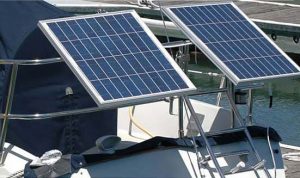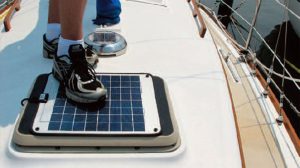Using Solar is green. It is renewable, available anywhere, durable, eco-friendly, cost effective, easy to install, utilises lower voltage and saves energy. It is becoming more and more popular on boats, right from trailer boats to larger motor yachts. Tom Burden (West Marine Advisor) looks at charging with solar panels and what you should look out for when going down the solar road.
Photovoltaic solar panels are a good way to replenish the DC power in your boat’s battery system. Small panels maintain or trickle charge batteries while you’re unplugged from shore power. Larger panels also charge batteries and produce enough energy to power applianIt is becoming more and more popular on boats, right from trailer boats to larger motor yachts. Tom Burden (West Marine Advisor) looks at charging with solar panels and what you should look out for when going down the solar road.ces, like an inverter used for producing household-type AC power. A solar panel can keep the battery fully charged when the boat is on the trailer or at a berth. All batteries self-discharge, and a small panel can eliminate the problems caused by dead batteries. Since solar panels put out pure DC power, they are excellent chargers as long as they have a regulator in the circuit when they require it.
How much energy do you want to generate?

Solar panels charge 12V batteries, and might have a voltage of 20V with no battery in the circuit, but are engineered to provide their power at the voltage a 12V battery requires for full charging. Panels are measured in either Watts, or Amps, or both. Generally, in the marine industry we talk in Amps since most boat owners have an idea of how many amp-hours their battery capacity is, or how many amp-hours they use in a day while cruising. Also, a simplifying assumption is that is the panel will put out its maximum output for five hours a day.
As they say in the car commercials,”your mileage may vary,” but this rule of thumb works well for estimating a panel’s output. You can arrive at these values by averaging the number of hours the panel spends in full sun (defined as 1000 watts of energy per square metre). Full sun means enough light so you see fairly sharp-edged shadows (most locations get no more than 80 to 85% of full sun). In general, the amount of time a panel spends in full sun averages four or five hours per day.
Problem with shading cells
Shadows covering even a tiny fraction of the panel have a dramatic impact on power output, for crystalline panels only. Shaded cells show a large voltage drop that acts as a barrier to useful power production, and shading a single cell on a panel can cut its output by 20% or more. Shading two or more cells effectively turns off the panel until the shadow is removed. This defect is corrected somewhat by the use of bypass diodes across each cell, which allows the module to produce power even when partially shaded.

Pointing the array squarely with the panels perpendicular to the sun makes a large difference in efficiency as well as does the temperature. The colder the temperature at the panel surface, the higher the output. Performance on a clear, cold winter morning can be 30 to 40% over rated specs.
Sizing the panels for your battery
Math shortcut: Take the output of the solar panel (in milliamps) and divide it by two.That’s about the size of the battery it can maintain. A 150mA solar panel can keep a battery up to about 75Ah. The 1500mA panel can provide enough power to keep a large bank of batteries topped off, assuming there are no loads on the batteries other than self-discharge.
Do you need a charge controller?

As a general rule panels that produce less than 1.5% of a battery’s rated capacity in amp hours don’t require regulation. This means that a 1.5A panel is the largest you should use without a regulator on a 100-amp-hour battery. Regulators should be used anytime you have two or more large panels connected to your batteries. If you’re concerned about damaging your new gel or AGM batteries due to overcharging, you can add a small, inexpensive charge controller.
These controllers, also called regulators, are rated by the maximum number of amps in your solar array. Regulators are ideal if you can’t be onboard to monitor your electrical system, and the top units now feature smart, multi-stage charging.
Permanently mounted or temporary?
Larger rigid panels can be permanently mounted in a custom-made bracket, especially when used aboard a cruising vessel. Rollable panels are made for the marine environment, and can be permanently mounted using their corner grommets. They’re also very easy to remove and store compactly. Foldable panels are made for temporary use since they’re less weatherproof than the other types.
Types of solar panels
Two types of panels use either silicon crystals or thin chemical films to generate electricity. Mono-crystalline and multi-crystalline (c-Si) panels are the oldest technology and also the most powerful. When sized correctly and matched to appropriate batteries, these are the panels to use for running large DC loads such as lights, a TV, radio or VCR. In crystalline panels, silicon, the primary material in quartz sand, is grown into crystals, refined, purified (by an expensive process), sliced into thin wafers and “doped” with the addition of chemicals.

Solar cells create electrical current, the quantity determined by the size and efficiency of the cell and the amount of light. Solar modules are created by connecting cells in parallel to increase amperage and in series to increase voltage. Typical solar modules have 30 or 36 cells (generating between 14 and 18V DC).
Amorphous thin film Silicon (a-Si) panels are only about 50% as efficient as multi-crystalline panels, but can be manufactured in flexible forms so they can roll or fold, or conform to the shape of a cabin top. They are more efficient in low or diffused light conditions and are less subject to voltage drops when they heat up. They’re the panels most often used for low amperage charging and battery maintenance. They don’t have enough output for serious energy replenishment, but can be used to “float” or trickle charge a battery. Thin film panels require lower manufacturing costs than c-Si panels like the Nature Power panels (with 45% of crystalline panel cost coming from making the raw silicon crystal structure).
Simple rules for best power production
Keep the panels as perpendicular to the incoming sun’s rays as possible. If you’ve mounted panels on a boat on a mooring, you may not be able to guarantee that they are pointing towards the sun, but all panels will produce more power if they get direct sunlight. This is a compelling reason to mount panels on cruising boats so that they can be aimed in the appropriate direction, no matter what the season, course, or latitude. Try to avoid shadows, as the output of a panel (particularly a crystalline panel) drops dramatically when shadowed, even if only 10% of the panel is in shadow. A small shadow can reduce the panel’s output by 50% or more. When something as large as a radar scanner or rocket launcher casts its shadow on a panel, your output goes down dramatically. It is also important to keep your panels cool. It’s not easy to keep a black surface cool in the sun, but panel output goes down as temperature rises, so if you can provide some ventilation on the backside of the panel, you may be able to pick up a 5 or 10% increase.




